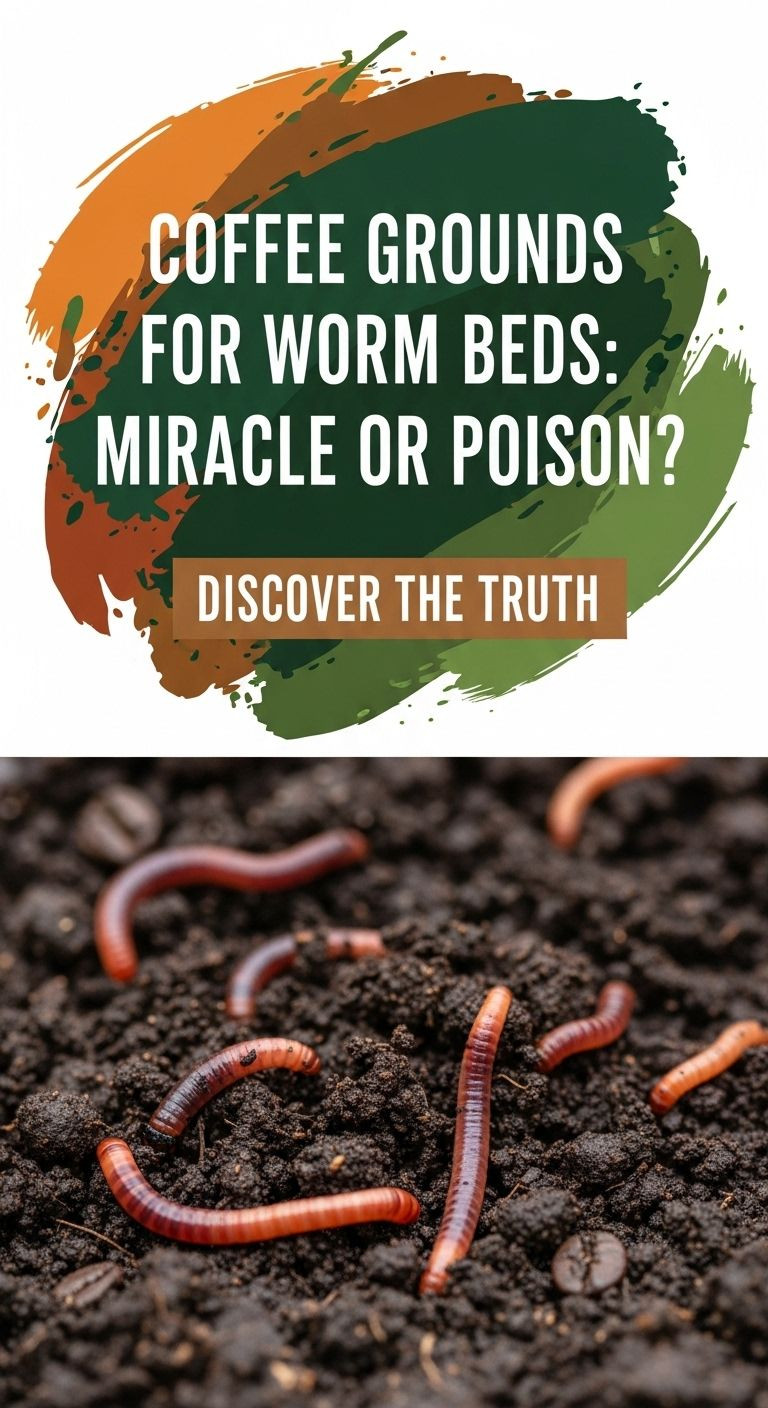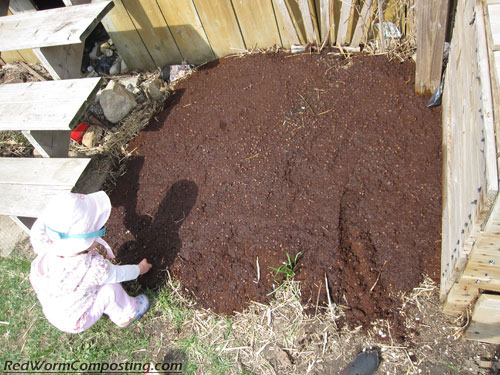As an Amazon Associate CoffeeXplore.com earns from qualifying purchases.
Coffee Grounds for Worm Beds: Miracle or Poison?
The daily ritual of brewing coffee leaves behind a fragrant, dark treasure: used coffee grounds. For the dedicated vermicomposter, the question immediately arises—can this go into the worm bin? The internet is filled with conflicting advice, creating a confusing picture for anyone trying to do right by their wriggly workers. You’re left wondering if you’re about to supercharge your compost or create a toxic disaster.
So, are coffee grounds a miracle food or a potential poison for your worm bed? The truth, as is often the case in nature, lies in the details. This guide cuts through the confusion, providing a clear, data-driven path to using coffee grounds effectively and safely in your worm farm. We’ll explore the proven benefits, the real risks, and the exact steps to turn your daily coffee habit into a powerhouse ingredient for your worms and your garden.
Key Facts
- Balanced pH: Used coffee grounds are not highly acidic; their pH is typically near neutral (6.5-6.8), making them safe for worm beds in moderation, as most acid is removed during brewing.
- Nitrogen Powerhouse: Coffee grounds are a valuable “green” material, rich in nitrogen, which is essential for the microbial activity that helps worms like red wigglers grow larger and process waste more efficiently.
- The Moderation Rule: To prevent issues, a critical guideline suggests that coffee grounds should never constitute more than 1/8th of the total material in your worm bin.
- Risk of Compaction: The fine texture of coffee grounds means they can easily compact if added in thick layers, restricting airflow and creating foul-smelling anaerobic conditions that are harmful to worms.
- Filters are Friends: Standard paper coffee filters are completely biodegradable and are considered a valuable “brown” or carbon-rich material that can be tossed directly into the bin along with the grounds.
The Benefits: Why Worms Are Attracted to Coffee Grounds
When managed correctly, adding used coffee grounds to your worm farm is one of the best things you can do for your composting ecosystem. Far from being just filler, they provide tangible benefits that boost worm health and improve the final quality of your vermicompost. Worms are drawn to the grounds as they begin to decay, feasting on the rich microbial life that grows on them.
Pro Tip: “Think of used coffee grounds as a pre-processed, nitrogen-rich meal that helps your worms grow larger and faster, boosting your vermicomposting efficiency.”

Here’s a breakdown of why coffee grounds are so good for your worm bed:
- Rich Nitrogen Source: Coffee grounds are an excellent source of nitrogen, which acts as a protein source for your worms and a fuel for the beneficial microorganisms in the bin. This microbial activity is what truly breaks down organic matter, and the grounds give this process a significant boost.
- Valuable Organic Matter: They add a significant amount of fine-particled organic matter to your bin. As worms process this material, it contributes to a finer, richer final product. This improves the structure, aeration, and water retention of the finished vermicompost, making it a superior soil amendment for your garden.
- Surprisingly Neutral pH: A common myth is that coffee grounds will make your worm bin dangerously acidic. While fresh, unbrewed grounds are acidic, the brewing process washes most of the acid away. Well-established research indicates that used coffee grounds have a neutral pH, typically between 6.5 and 6.8, which is perfectly safe and even ideal for a worm bed environment.
- Gritty Texture Aids Digestion: While not a primary source of grit, the fine, gritty texture of coffee grounds can assist in the worms’ digestive process. Worms have a gizzard and use small, hard particles to help grind up their food, and grounds can contribute to this action.
The Risks: How Coffee Grounds Can Harm Your Worms if Mismanaged
For every story of coffee grounds creating “black gold,” there’s a cautionary tale of a bin gone wrong. The key takeaway is that the grounds themselves are not the problem; improper management is. Understanding the potential risks is the first step to avoiding them entirely and ensuring your worms thrive.
Think of it like a rich dessert for your worms. A small amount is a wonderful treat, but a diet of only cake will lead to serious problems. The same principle applies here. Overloading your bin with coffee grounds can rapidly shift its delicate balance, turning a healthy home into a hazardous environment.
Here are the primary risks and how to prevent them:
| Risk Factor | Why It Happens | Impact on Worms |
|---|---|---|
| Acidity Spike | Adding excessive amounts or using fresh, unbrewed grounds. | Creates an inhospitable, acidic environment worms cannot tolerate, leading to sickness or death. |
| Excess Moisture | Grounds retain a lot of water; added without balancing with dry bedding. | Can lead to soggy, waterlogged, and anaerobic conditions that literally suffocate worms. |
| Compaction | Fine grounds are dumped in thick, dense layers without being mixed in. | Restricts airflow, leading to foul odors, putrefaction, and deadly anaerobic pockets in the bin. |
| Caffeine Toxicity | Overloading the bin with a high concentration of grounds at once. | While the risk is low in used grounds, an extreme overload of caffeine can be detrimental to worm health. |
The How-To: Safely Adding Coffee Grounds to Your Worm Bed (Step-by-Step)
Now that you understand the benefits and risks, you can confidently incorporate coffee grounds into your vermicomposting routine. The secret to success isn’t complicated; it boils down to moderation, balance, and proper technique. By following these simple steps, you’ll provide your worms with a food source they love while keeping the bin environment stable and healthy.
The golden rule of vermicomposting is to introduce any new food source slowly and in moderation. Observe how your worms react before making it a major component of their diet.

Step 1: Prioritize Used Grounds over Fresh
This is the most critical first step. Always choose used coffee grounds for your worm bin. The brewing process leaches out most of the water-soluble acids, rendering the grounds near-neutral. Data shows used grounds have a pH of 6.5-6.8. In contrast, fresh (unbrewed) coffee grounds are highly acidic and can quickly lower the pH of your bin to levels that are harmful to worms. Only use fresh grounds very sparingly, if at all.
Step 2: Master the Art of Moderation & Balance
Coffee grounds are a nitrogen-rich “green” material. To maintain a healthy ecosystem, you must balance them with carbon-rich “brown” materials. This maintains a healthy carbon-to-nitrogen ratio, preventing the bin from becoming a smelly, sludgy mess.
Pro Tip: “A simple rule is for every part of ‘green’ food scraps like coffee grounds you add, add at least two to three parts of ‘brown’ bedding like shredded cardboard or dry leaves.”
- The 1/8th Rule: As a firm guideline, coffee grounds should never make up more than 1/8th of the total material in your worm farm at any given time.
- Balance with Browns: For every scoop of coffee grounds you add, mix in two to three scoops of ‘browns’. Excellent brown materials include shredded newspaper (non-glossy), cardboard, dried leaves, or egg cartons.
- Don’t Forget the Filters: Quick Fact: “Did you know that paper coffee filters are also a great ‘brown’ material? You can toss them right in with the grounds!”
Step 3: Mix Well and Aerate
Never dump coffee grounds on top of your bedding in a thick, dense clump. Their fine texture makes them prone to compaction, which cuts off oxygen and creates anaerobic conditions—a death sentence for your worms.
The best practice is to sprinkle the grounds in a thin layer and then gently mix them into the top few inches of your existing bedding. This ensures they are well-distributed, prevents compaction, and allows the worms to access them easily from all sides. A practical approach frequently seen to yield results involves using a small hand rake or gloved hands to fold the grounds into the bedding material.

To ensure your worm composting journey is a success, getting the right supplies can make all the difference. Investing in a quality worm bin and some initial bedding material helps create the perfect environment from day one.
FAQs: Your Coffee Ground & Worm Bed Questions Answered
Even with the best instructions, specific questions often pop up. Here are direct answers to the most common queries about using coffee grounds in a worm bed, based on established best practices.
How much coffee grounds can I put in my worm farm?
A safe guideline is that coffee grounds should not make up more than 1/8th of the total bedding and food material in your worm bin. For an average-sized home bin, this might mean adding the grounds from your daily pot of coffee every few days, not every single day. Always balance it with plenty of carbon-rich “brown” bedding.
Are coffee grounds considered grit for worms?
While worms may ingest fine particles from grounds, they are not an ideal source of grit. Crushed eggshells are a much better option as they also help neutralize acidity. Worms require a gritty material in their gizzards to help them break down food. Eggshells provide this grit perfectly and offer the added benefit of releasing calcium carbonate, which buffers the pH of the bin.
Can worms eat coffee filters?
Yes, paper coffee filters are biodegradable and can be added directly to the worm bin. They count as a valuable “brown” or carbon-rich material. There’s no need to separate the filter from the grounds; you can toss the entire package in. Just be sure to tear it up a bit to help it break down faster.
What should I do if my bin becomes too acidic?
If your bin becomes too acidic from too many coffee grounds or other foods, add a small amount of finely crushed eggshells to help neutralize the pH. Sprinkle a tablespoon or two of powdered eggshells across the surface. This is a simple, effective remedy that provides a slow release of calcium carbonate to buffer the bin’s environment back to a neutral state.
What not to put in a worm bed?
Avoid adding meats, oils, and dairy products to your worm bin, as they can attract pests, create foul odors, and harm your worms. You should also avoid citrus fruits in large quantities due to their acidity, as well as salty or processed foods. Stick to raw fruit and vegetable scraps, crushed eggshells, and balanced brown materials.
Final Summary: Using Coffee Grounds for a Thriving Worm Bed
The debate over whether coffee grounds are good for worm beds can finally be put to rest. The answer is a resounding yes, but with a critical asterisk: they must be used with knowledge and care. By treating them as a potent nitrogen supplement rather than a primary food source, you can unlock their full potential without falling into the common traps of acidity, moisture, or compaction.
You now have the complete picture. You understand that used grounds are best, moderation is non-negotiable, and balancing them with carbon-rich browns is the key to a healthy, productive bin.
- Moderation is Key: Never let grounds exceed 1/8th of your bin’s total volume.
- Balance is Everything: Always mix grounds with 2-3 parts of “browns” like shredded paper or leaves.
- Mix, Don’t Dump: Always spread grounds in thin layers and mix them into the bedding to prevent compaction.
- Observe Your Bin: Pay attention to moisture levels and smells. Your bin is a living ecosystem that will tell you when something is off.
Go ahead and confidently add those used coffee grounds to your worm bin and turn your morning habit into black gold for your garden
Last update on 2025-12-06 / Affiliate links / Images from Amazon Product Advertising API

